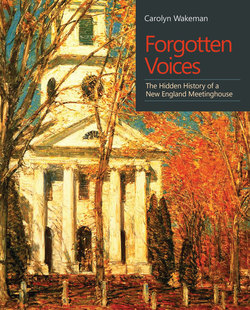Читать книгу Forgotten Voices - Carolyn Wakeman - Страница 18
На сайте Литреса книга снята с продажи.
ОглавлениеCHAPTER ELEVEN
The Minister’s Wife
The playful reputation of the minister’s wife dates from 1876, more than a century after her death, when a magazine article celebrating Lyme’s prominent families included a fanciful anecdote about her pranks in the meetinghouse.
His wife was given to practical jokes. One evening as he was about to leave the house for the weekly prayer-meeting—after taking a last look in the mirror to satisfy himself that every particular hair was stroked the right way—she playfully threw her arms about his neck, passed one hand over his face, and kissed him. As he entered the church he was nettled by a ripple of smiles which ran through the congregation, and he noticed that some of the brethren were eyeing him suspiciously. Presently it was whispered in his ear that his face was blackened.
The vivid details in a whimsical narrative about Phoebe Griswold (1716–1770), who at age fifteen married the town’s new minister, ten years her senior, are likely apocryphal. They seem to have originated a century after her death when Evelyn McCurdy Salisbury (1823–1917), a Griswold descendant eager to highlight the family’s distinguished marriages and praise “the beauty and spirit of its women,” provided a colorful anecdote to historian and journalist Martha J. Lamb (1829–1923). Mrs. Lamb included the charming story in her article celebrating Lyme’s illustrious past, which appeared in the centennial issue of Harper’s Magazine in 1876. The incidents she recounted became fixed in local lore and still shape the remembered past today.
Martha Lamb’s purpose was to engage her magazine audience in an appealing portrayal of a historic Connecticut town. Her article describes how Parsons arranged his hair in front of a mirror, kissed his wife goodbye, and left for a weekly prayer gathering in the meetinghouse, where his smudged face elicited “a ripple of smiles.” It details an additional occasion in the meetinghouse when his “fun-loving wife,” who “was given to practical jokes,” removed a page from his sermon, then “sat in the little square pew before him, quietly fanning herself, and enjoying his embarrassment when he reached the chasm.” The anecdote later became confused with fact, as if Mrs. Lamb were actually reporting the reaction of those gathered in Lyme’s meetinghouse for a prayer meeting and a sermon in the 1730s.
Historian Martha J. Lamb drew national attention to Old Lyme’s scenic beauty and the achievements of its “consequential families” in an illustrated profile of the town that appeared in 1876 in the centennial issue of Harper’s Monthly.
Parsons’s own accounts of his ministry in Lyme offer no hint of playfulness in his household. He described efforts to eliminate youthful frivolity in the parish and reported that young people, at his urging, “turned their meetings for vain mirth into meetings for prayer, conference, and reading books of piety.” They then took pains, the minister noted, “to dissuade others from levity and frothy conversation.” His accounts of his ministry mention his wife only once, when he described his severe mental struggle after settling in Lyme. “Sometimes I thought I must be in hell,” he explained, and “I thought everyone that saw me must see my wretchedness.” When “Mrs. Parsons, taking notice of something extraordinary, asked what was the matter,” the minister told her that he “could not live so,” then retired “unto a secret place in the field” where he remained on his knees alone with his Bible.”
When Martha Lamb described Jonathan Parsons’s manly and good-humored face looking down from a portrait, she likely referred to this “crayon” copy of a painting by John Singleton Copley showing the minister with the hint of a smile.
Although Martha Lamb portrayed Jonathan Parsons as an affectionate and indulgent husband, a grandson’s memoir commented that his “natural temper was hasty and rather unlovely,” and that “it cost him a struggle to keep it under, to the end of his life.” But John Singleton Copley’s (1738–1815) portrait of the minister in middle age seemed to confirm Mrs. Lamb’s impression of his amiable temperament. Observing a pastel copy that showed Parsons in black robe and clerical collar with the hint of a smile, she remarked that a “fair, frank, manly, good-humored face looks down.” She also claimed, without any known evidence, that his “passion for fine clothes, for gold and silver lace, and ruffled shirt fronts” caused distress among “some of the good Puritans in his church.” Today those details allow Parsons to be described as Phoebe Griswold’s “dandy of a husband.”
Only the outlines of Mrs. Parsons’s life can be established. She grew up in a prominent Lyme family, married young, and faced repeated tragedy when six of her thirteen children died before adulthood. Her response when bitter contention divided Lyme’s church and when her brother Matthew Griswold (1714–1799), later Connecticut’s governor, served as her husband’s most outspoken advocate is not known. When Parsons’s troubled ministry in Lyme ended in 1745, she moved at age twenty-nine to Newbury, Massachusetts, where she died a quarter of a century later in 1770. A funeral sermon praised Phoebe Parsons’s exceptional capabilities. It commended her mental endowments, her Christian simplicity and integrity, her knowledge of divinity, and her rare acquaintance with church history. It also noted her liveliness and keenness of wit.
The funeral sermon that Rev. John Searle preached in Newbury after the death of Phoebe Parsons in 1771 commended her knowledge and integrity and noted her keenness of wit.
